Insights into People’s Perceptions Towards Urban Public Spaces Through Analysis of Social Media Reviews: A Case Study of Shanghai †
Abstract
1. Introduction
2. Research Methods
2.1. Study Area
2.2. Data Collection and Analysis
2.2.1. The Data
2.2.2. Data Analysis
3. Results
3.1. Perceptions Toward Different Categories of Urban Streets
3.2. Associations Between Perceptions on Urban Streets and Built Environment Elements
4. Discussion and Conclusions
Author Contributions
Funding
Data Availability Statement
Conflicts of Interest
References
- Hand, K.L.; Freeman, C.; Seddon, P.J.; Recio, M.R.; Stein, A.; Van Heezik, Y. The importance of urban gardens in supporting children’s biophilia. Proc. Natl. Acad. Sci. USA 2017, 114, 274–279. [Google Scholar] [CrossRef]
- Plunz, R.A.; Zhou, Y.; Vintimilla, M.I.C.; Mckeown, K.; Yu, T.; Uguccioni, L.; Sutto, M.P. Twitter sentiment in New York City parks as measure of well-being. Landsc. Urban Plan. 2019, 189, 235–246. [Google Scholar] [CrossRef]
- Sheikh, W.T.; van Ameijde, J. Promoting livability through urban planning: A comprehensive framework based on the “theory of human needs”. Cities 2022, 131, 103972. [Google Scholar] [CrossRef]
- Veenhoven, R. Livability theory. In Encyclopedia of Quality of Life and Well-Being Research; Springer: Dordrecht, The Netherlands, 2024; pp. 3947–3949. [Google Scholar]
- Tsoy, D.; Tirasawasdichai, T.; Kurpayanidi, K.I. Role of social media in shaping public risk perception during COVID-19 pandemic: A theoretical review. Int. J. Manag. Sci. Bus. Adm. 2021, 7, 35–41. [Google Scholar] [CrossRef]
- Liu, W.; Li, D.; Meng, Y.; Guo, C. The Relationship between Emotional Perception and High-Density Built Environment Based on Social Media Data: Evidence from Spatial Analyses in Wuhan. Land 2024, 13, 294. [Google Scholar] [CrossRef]
- Li, J.; Gao, J.; Zhang, Z.; Fu, J.; Shao, G.; Zhao, Z.; Yang, P. Insights into citizens’ experiences of cultural ecosystem services in urban green spaces based on social media analytics. Landsc. Urban Plan. 2024, 244, 104999. [Google Scholar] [CrossRef]
- Song, Y.; Fernandez, J.; Wang, T. Understanding perceived site qualities and experiences of urban public spaces: A case study of social media reviews in Bryant Park, New York City. Sustainability 2020, 12, 8036. [Google Scholar] [CrossRef]
- Chen, S.; Biljecki, F. Automatic assessment of public open spaces using street view imagery. Cities 2023, 137, 104329. [Google Scholar] [CrossRef]
- Lynch, K. The image of the environment. In The Image of the City; Lynch, K., Ed.; MIT Press: Cambridge, MA, USA, 1960; pp. 1–13. [Google Scholar]
- Al Mushayt, N.S.; Cin, F.D.; Proença, S.B. New lens to reveal the street interface. A morphological-visual perception methodological contribution for decoding the public/private edge of arterial streets. Sustainability 2021, 13, 11442. [Google Scholar] [CrossRef]
- Hassen, N.; Kaufman, P. Examining the role of urban street design in enhancing community engagement: A literature review. Health Place 2016, 41, 119–132. [Google Scholar] [CrossRef]
- Zhu, Y.; Zhang, Y.; Biljecki, F. Understanding the user perspective on urban public spaces: A systematic review and opportunities for machine learning. Cities 2025, 156, 105535. [Google Scholar] [CrossRef]
- Qi, J.; Mazumdar, S.; Vasconcelos, A.C. Understanding the Relationship between Urban Public Space and Social Cohesion: A Systematic Review. Int. J. Community Well-Being 2024, 7, 155–212. [Google Scholar] [CrossRef]
- Fainstein, S.S. Tourism and the commodification of urban culture. Urban Reinventors Celebr. Urbanity 2007, 2, 1–20. [Google Scholar]
- Schwarz, M. Planting Commons through Art? Aesthetics of Commons and Commodification in Two Community Gardens in Berlin and Dakar. Str. Art Urban Creat. Sci. J. 2023, 9, 68–79. [Google Scholar]
- Zheng, J. “Aesthetic regime” in urban entrepreneurialism: Public art venues in Shanghai. Asian Educ. Dev. Stud. 2019, 8, 109–125. [Google Scholar] [CrossRef]
- Zukin, S.; Braslow, L. The life cycle of New York’s creative districts: Reflections on the unanticipated consequences of unplanned cultural zones. City Cult. Soc. 2011, 2, 131–140. [Google Scholar] [CrossRef]
- Villani, C.; Talamini, G. Pedestrianised streets in the global neoliberal city: A battleground between hegemonic strategies of commodification and informal tactics of commoning. Cities 2021, 108, 102983. [Google Scholar] [CrossRef]
- Su, X. Urban entrepreneurialism and the commodification of heritage in China. Urban Stud. 2015, 52, 2874–2889. [Google Scholar] [CrossRef]
- Herrmann-Lunecke, M.G.; Mora, R.; Vejares, P. Perception of the built environment and walking in pericentral neighbourhoods in Santiago, Chile. Travel Behav. Soc. 2021, 23, 192–206. [Google Scholar] [CrossRef]
- Huang, J.; Wang, Y.; Wu, K.; Yue, X.; Zhang, H.O. Livability-oriented urban built environment: What kind of built environment can increase the housing prices? J. Urban Manag. 2024, 13, 357–371. [Google Scholar] [CrossRef]
- Klompmaker, J.O.; Hoek, G.; Bloemsma, L.D.; Gehring, U.; Strak, M.; Wijga, A.H.; van den Brink, C.; Brunekreef, B.; Lebret, E.; Nicole, A.H.J. Green space definition affects associations of green space with overweight and physical activity. Environ. Res. 2018, 160, 531–540. [Google Scholar] [CrossRef]
- Jorgensen, B.S.; Stedman, R.C. A comparative analysis of predictors of sense of place dimensions: Attachment to, dependence on, and identification with lakeshore properties. J. Environ. Manag. 2006, 79, 316–327. [Google Scholar] [CrossRef]
- Tu, W.; Cao, J.; Yue, Y.; Shaw, S.L.; Zhou, M.; Wang, Z.; Chang, X.; Xu, Y.; Li, Q. Coupling mobile phone and social media data: A new approach to understanding urban functions and diurnal patterns. Int. J. Geogr. Inf. Sci. 2017, 31, 2331–2358. [Google Scholar] [CrossRef]
- Singh, N.K.; Tomar, D.S.; Sangaiah, A.K. Sentiment analysis: A review and comparative analysis over social media. J. Ambient. Intell. Humaniz. Comput. 2020, 11, 97–117. [Google Scholar] [CrossRef]
- Dong, X.; Lian, Y. A review of social media-based public opinion analyses: Challenges and recommendations. Technol. Soc. 2021, 67, 101724. [Google Scholar] [CrossRef]
- Poell, T.; Borra, E. Twitter, YouTube, and Flickr as platforms of alternative journalism: The social media account of the 2010 Toronto G20 protests. J. Sage Publ. 2011, 13, 695–713. [Google Scholar] [CrossRef]
- Dobson, A.S. Postfeminist Digital Cultures: Femininity, Social Media, and Self-Representation; Springer: Berlin/Heidelberg, Germany, 2015; Volume 314. [Google Scholar]
- Song, Y.; Zhang, B. Using social media data in understanding site-scale landscape architecture design: Taking Seattle Freeway Park as an example. Landsc. Res. 2020, 45, 627–648. [Google Scholar] [CrossRef]
- Fernandez, J.; Song, Y.; Padua, M.; Liu, P. A framework for urban parks: Using social media data to assess Bryant Park, New York. Landsc. J. 2022, 41, 15–29. [Google Scholar] [CrossRef]
- Huang, Y.; Li, Z.; Huang, Y. User Perception of Public Parks: A Pilot Study Integrating Spatial Social Media Data with Park Management in the City of Chicago. Land 2022, 11, 211. [Google Scholar] [CrossRef]
- Ma, R.; Luo, Y.; Furuya, K. Classifying visually appealing elements in parks using social media data-assisted eye-tracking: Case study of Shinsui parks in Tokyo, Japan. J. Outdoor Recreat. Tour. 2023, 44, 100672. [Google Scholar] [CrossRef]
- Wang, Z.; Zhu, Z.; Xu, M.; Qureshi, S. Fine-grained assessment of greenspace satisfaction at regional scale using content analysis of social media and machine learning. Sci. Total Environ. 2021, 776, 145908. [Google Scholar] [CrossRef]
- Roberts, H.; Sadler, J.; Chapman, L. Using Twitter to investigate seasonal variation in physical activity in urban green space. Geo Geogr. Environ. 2017, 4, e00041. [Google Scholar] [CrossRef]
- Gibbons, J.; Malouf, R.; Spitzberg, B.; Martinez, L.; Appleyard, B.; Thompson, C.; Nara, A.; Tsou, M. Twitter-based measures of neighborhood sentiment as predictors of residential population health. PLoS ONE 2019, 14, e0219550. [Google Scholar] [CrossRef]
- De Vries, S.; Van Dillen, S.M.; Groenewegen, P.P.; Spreeuwenberg, P. Streetscape greenery and health: Stress, social cohesion and physical activity as mediators. Soc. Sci. Med. 2013, 94, 26–33. [Google Scholar] [CrossRef]
- Burton, N.W.; Haynes, M.; Wilson, L.A.M.; Giles-Corti, B.; Oldenburg, B.F.; Brown, W.J.; Giskes, K.; Turrell, G. HABITAT: A longitudinal multilevel study of physical activity change in mid-aged adults. BMC Public Health 2009, 9, 76. [Google Scholar] [CrossRef] [PubMed]
- Lehning; Amanda, J. Local and Regional Governments and Age-Friendly Communities: A Case Study of the San Francisco Bay Area. J. Aging Soc. Policy 2014, 26, 102–116. [Google Scholar] [CrossRef]
- Chang, S.W.; Rhee, D.Y.; Jun, H.J. A natural language processing framework for collecting, analyzing, and visualizing users’ sentiment on the built environment: Case implementation of New York City and Seoul residences. Archit. Sci. Rev. 2022, 65, 278–294. [Google Scholar] [CrossRef]
- Demirbaş, Ö.O.; Aral, H.E. Pedestrians’ Perception Of Sub-Spaces Along Urban Roads As Public Spaces –Case Of Eskişehir Road In Ankara. ODTÜ Mimar. Fakültesi Derg. 2015, 32, 45–64. [Google Scholar]
- Ashik, F.R.; Barrington-Leigh, C.P.; Manaugh, K. Street network connectivity leads to denser urban form in Canadian cities. Cities 2025, 161, 105844. [Google Scholar] [CrossRef]
- Kim, S.; Park, S.; Lee, J.S. Meso- or micro-scale? Environmental factors influencing pedestrian satisfaction. Transp. Res. Part D Transp. Environ. 2014, 30, 10–20. [Google Scholar] [CrossRef]
- Hsu, T.-C.; Lee, T.-C. Evaluating the Perceptions of Road Users in Different Scenarios of Shared Spaces. J. East. Asia Soc. Transp. Stud. 2017, 12, 1201–1217. [Google Scholar]
- Navarrete-Hernandez, P.; Mace, A.; Karlsson, J.; Holman, N.; Zorloni, D.A. Delivering higher density suburban development: The impact of building design and residents’ attitudes. Urban Stud. 2021, 59, 2801–2820. [Google Scholar] [CrossRef]
- Bratman, G.N.; Anderson, C.B.; Berman, M.G.; Cochran, B.; De Vries, S.; Flanders, J.; Folke, C.; Frumkin, H.; Gross, J.J.; Hartig, T.; et al. Nature and mental health: An ecosystem service perspective. Sci. Adv. 2019, 5, eaax0903. [Google Scholar] [CrossRef]
- Li, J.; Fu, J.; Gao, J.; Zhou, R.; Wang, K.; Zhou, K. Effects of the spatial patterns of urban parks on public satisfaction: Evidence from Shanghai, China. Landsc. Ecol. 2023, 38, 1265–1277. [Google Scholar] [CrossRef] [PubMed]
- Li, L.; Wang, L.; Chen, Y. Public Perception of Built Environment in Urban Street: A Text Emotion Analysis Approach. In Proceedings of the AHFE International Conference on Human Factors in Design, Engineering, and Computing, Honolulu, HI, USA, 8–10 December 2024. [Google Scholar]
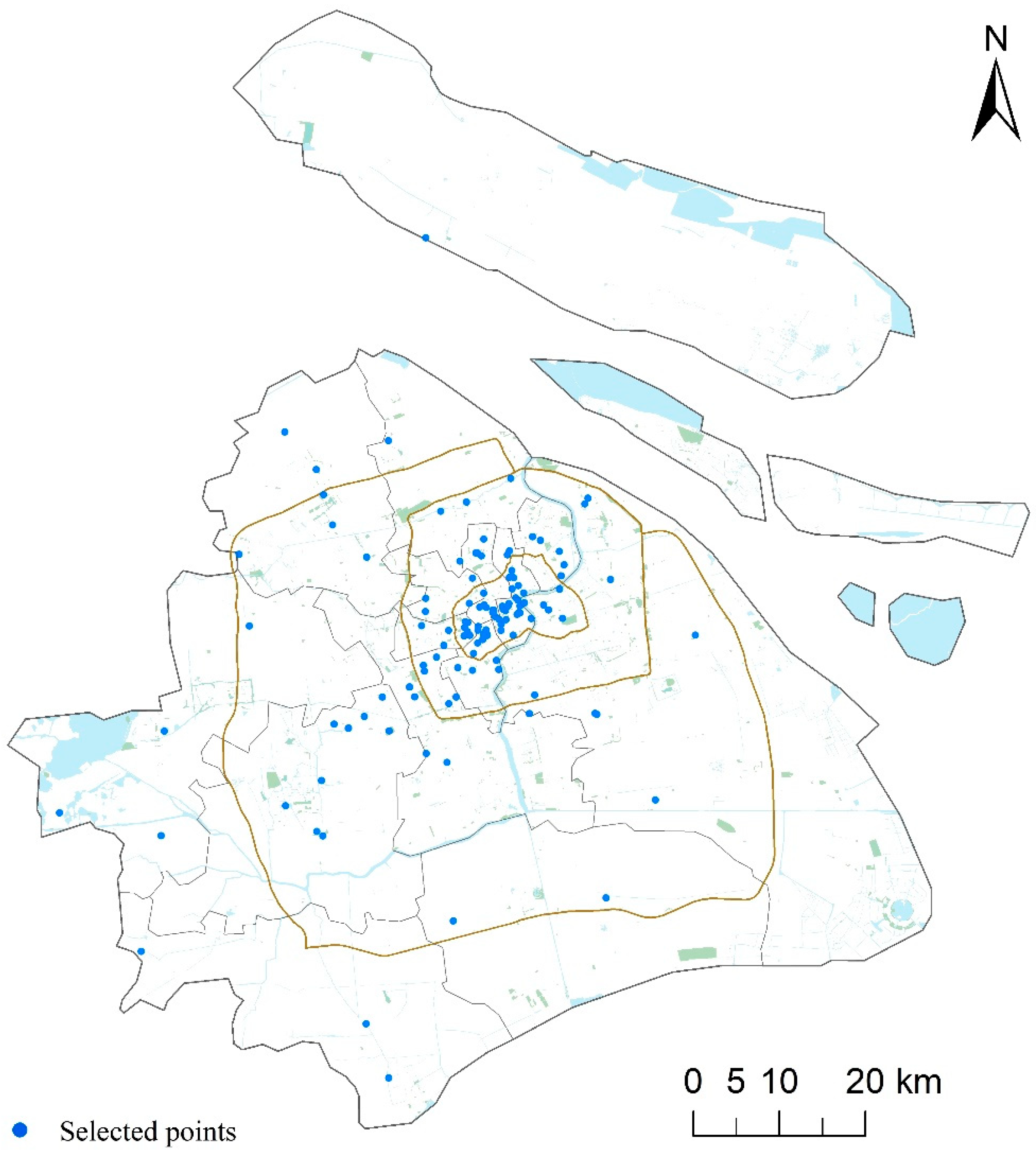
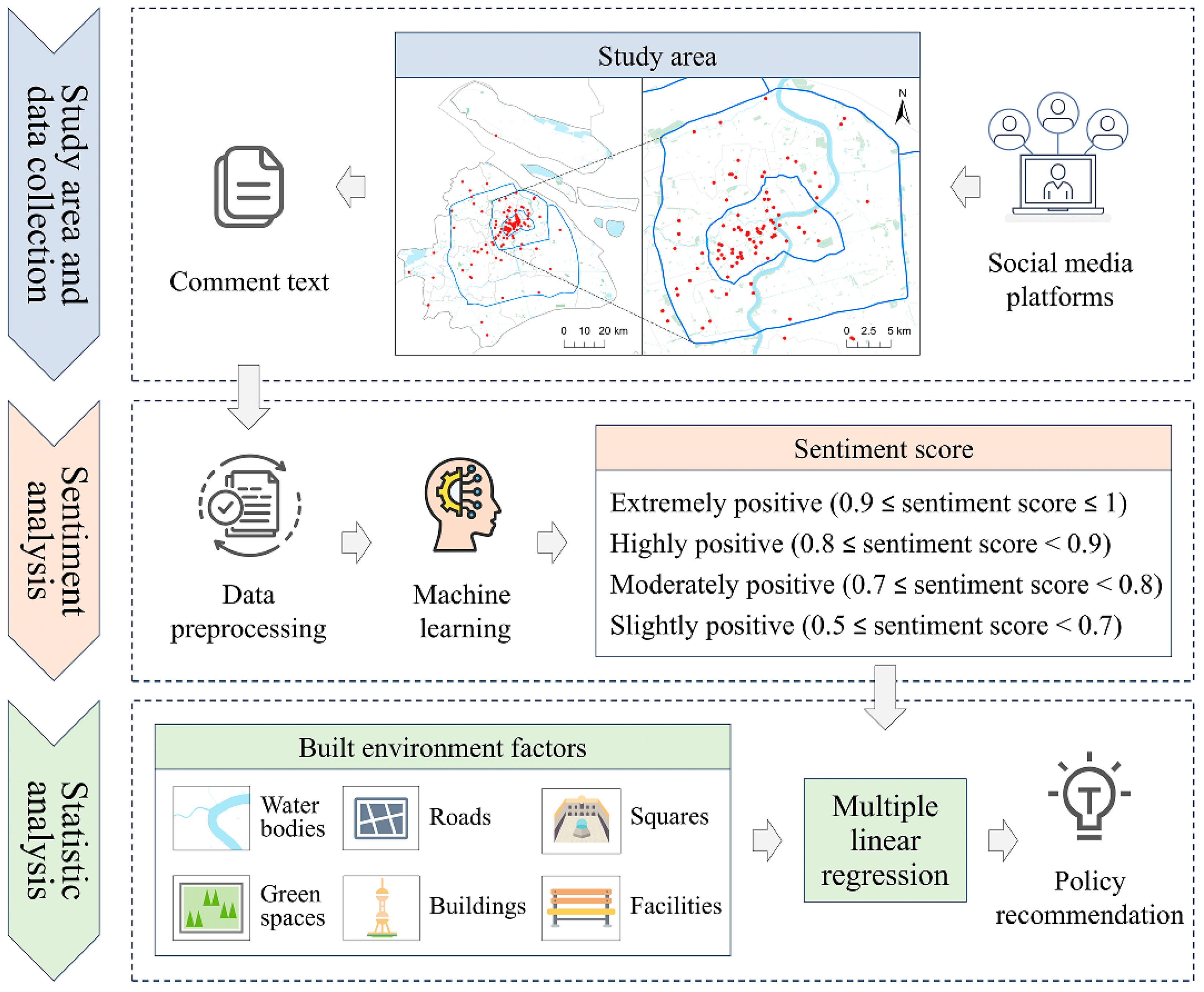
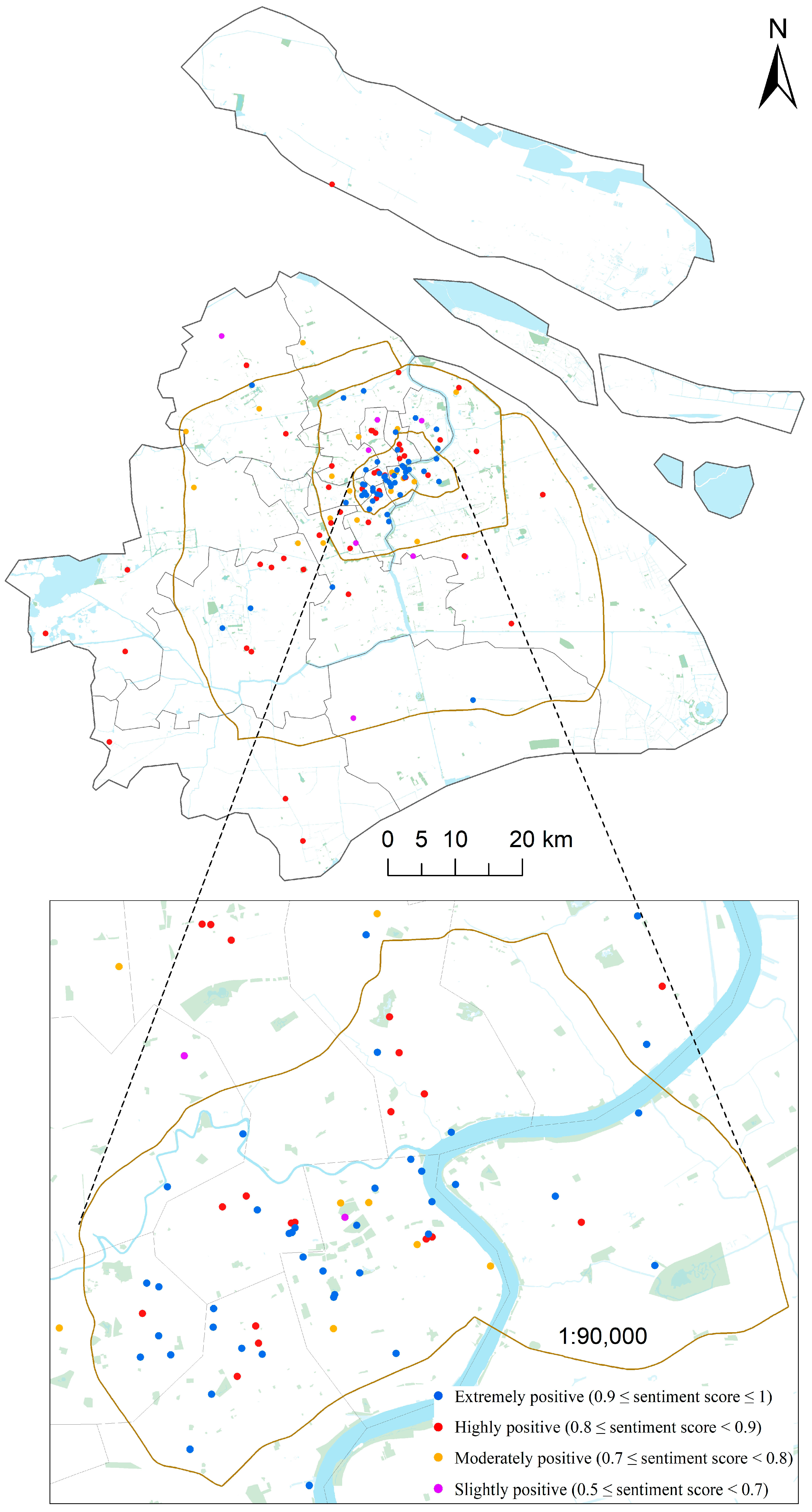
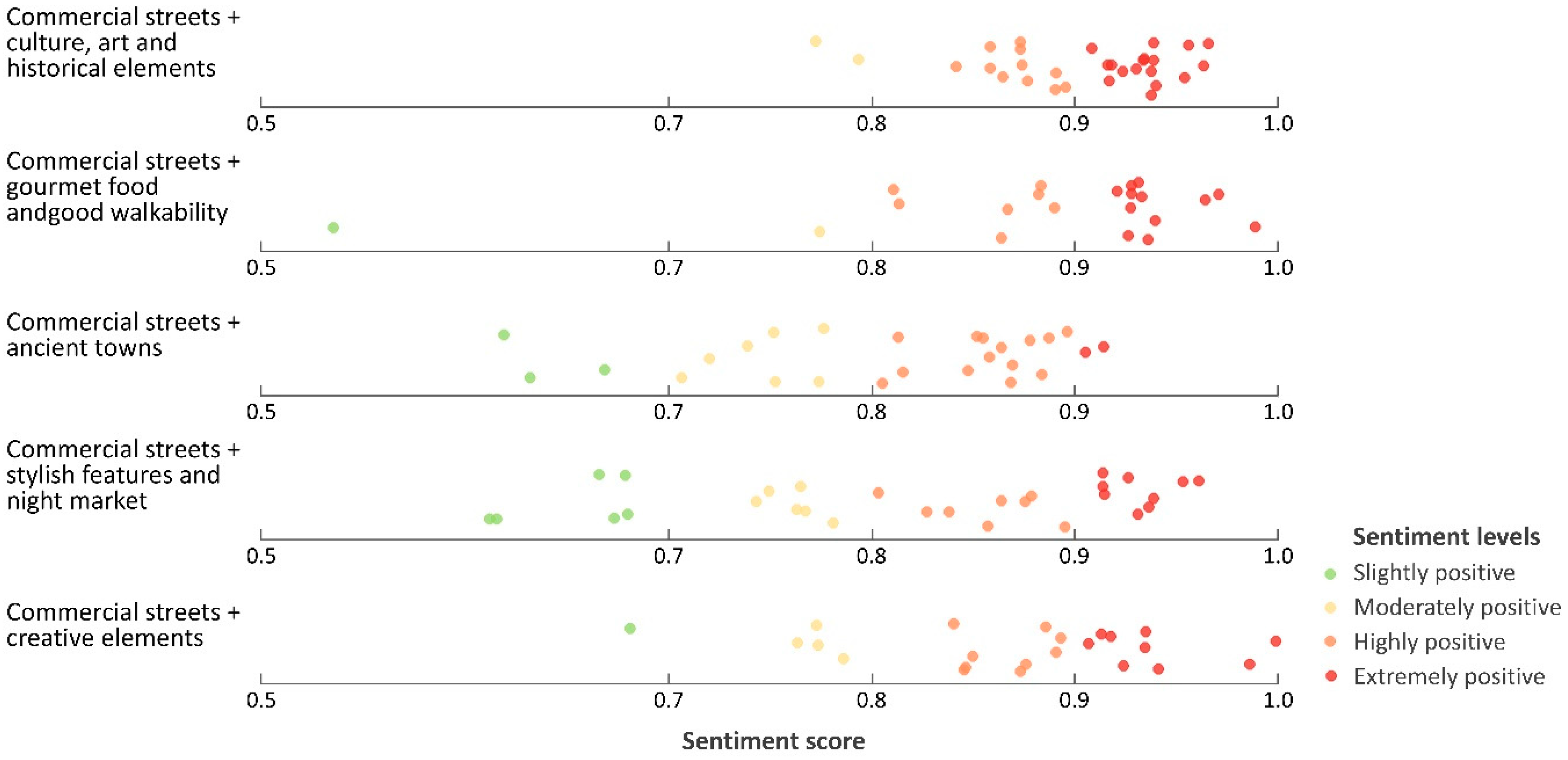
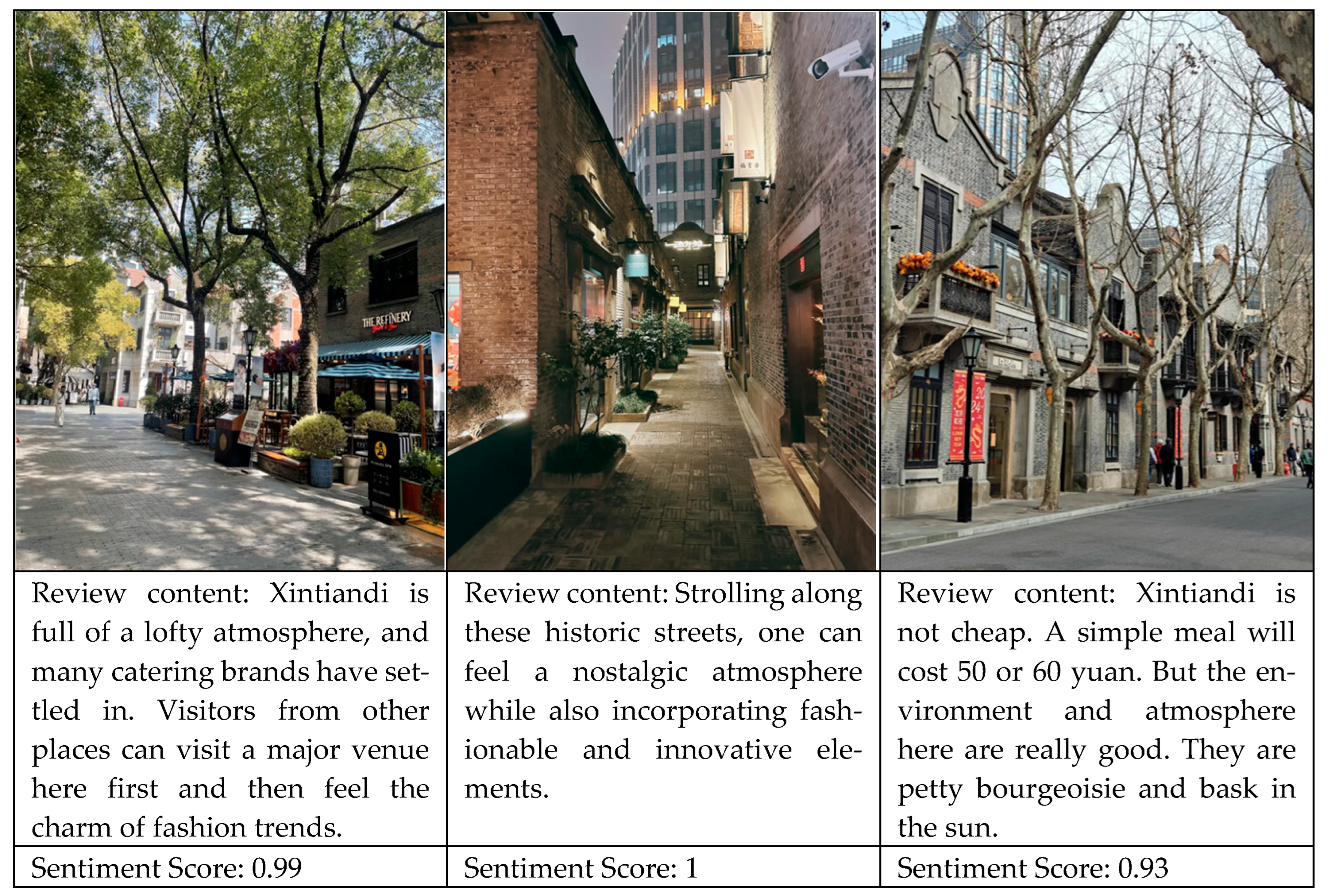
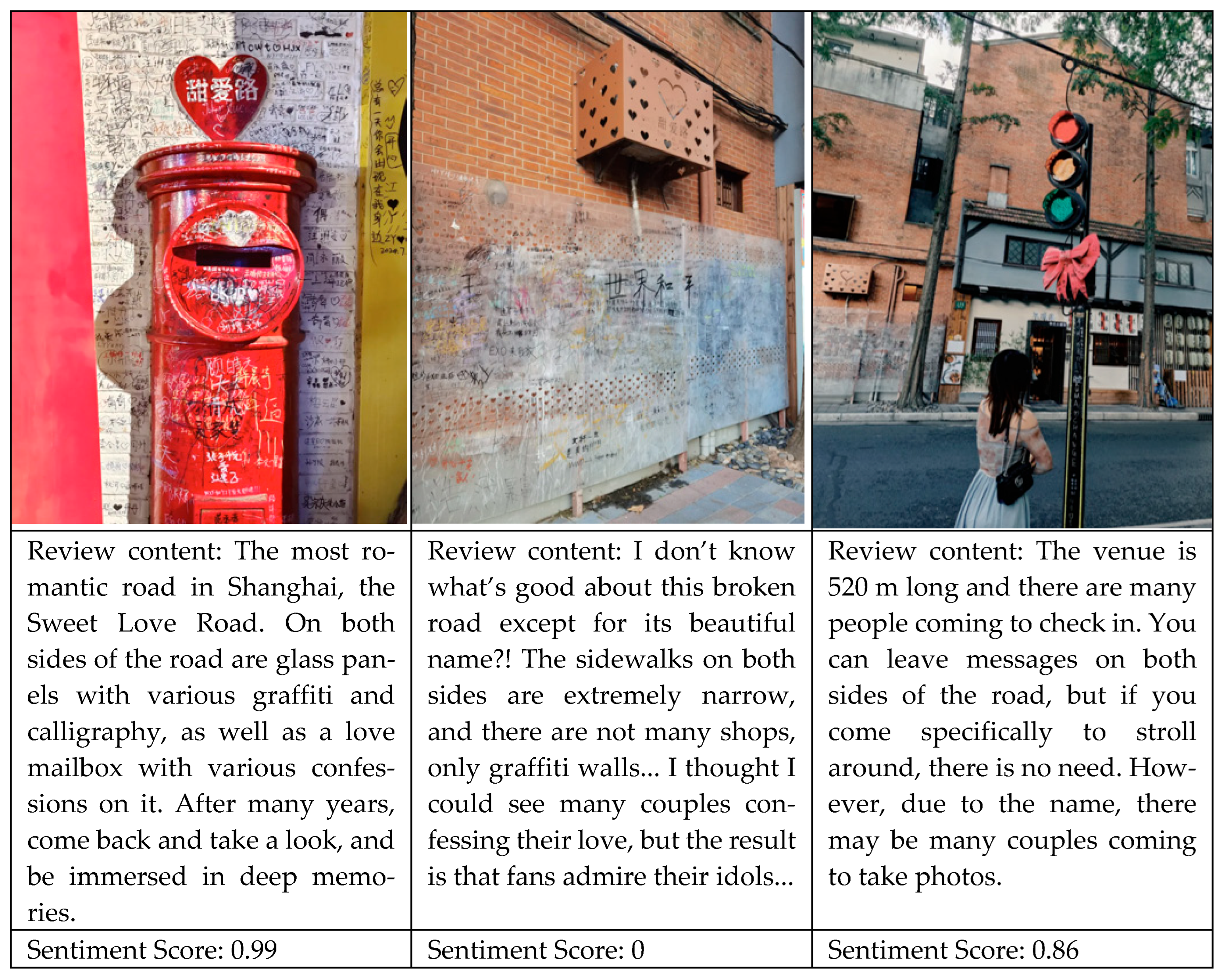

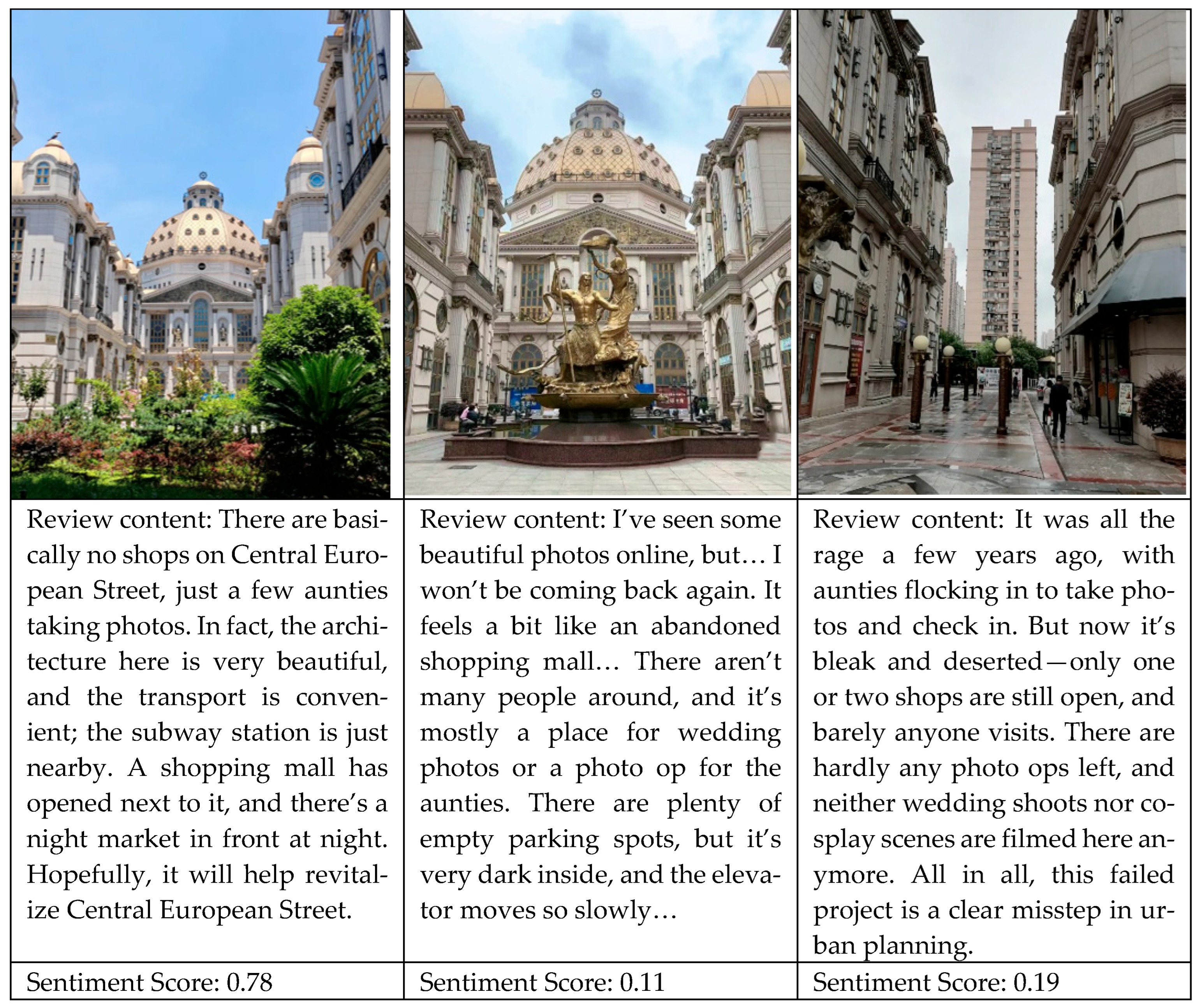
| Built Environment Elements | Lexicon | Associated Words |
|---|---|---|
| Water bodies | Natural or artificial water-filled areas, including rivers, lakes, waterfronts, canals, etc. | 33 |
| Roads | Paved or unpaved paths used for vehicular and pedestrian travel, including footpaths, alleys, lanes, bikeways, etc. | 27 |
| Buildings | Buildings or structures used for residential, commercial, industrial, artistic, or recreational purposes. | 33 |
| Green spaces | Areas that are covered with grass, trees, and other vegetation, including parks, gardens, lawns, etc. | 26 |
| Squares | Public open spaces, typically paved and surrounded by buildings, used for social or recreational activities. | 16 |
| Recreational facilities | Locations and structures designed for leisure activities, including pavilions, benches, seats, gazebos, kiosks, etc. | 13 |
| Elements | Associated Words | Sentences (Containing the Words) Frequency | Words Frequency | Sentiment Score |
|---|---|---|---|---|
| Water bodies | 33 | 54.87‰ | 14.83% | 0.871 |
| Roads | 27 | 182.62‰ | 49.60% | 0.846 |
| Buildings | 33 | 101.37‰ | 25.46% | 0.877 |
| Green spaces | 26 | 31.72‰ | 7.72% | 0.892 |
| Squares | 16 | 9.44‰ | 1.99% | 0.864 |
| Recreational facilities | 13 | 1.94‰ | 0.40% | 0.862 |
| Elements | B | SE | Beta | t-Value | p-Value | VIF |
|---|---|---|---|---|---|---|
| Water bodies | 0.038 | 0.029 | 0.075 | 1.296 | 0.198 | 1.134 |
| Roads | 0.495 | 0.065 | 0.478 | 7.579 | 0.000 | 1.341 |
| Buildings | 0.223 | 0.036 | 0.368 | 6.110 | 0.000 | 1.222 |
| Green spaces | 0.048 | 0.020 | 0.148 | 2.373 | 0.019 | 1.317 |
| Squares | 0.000 | 0.013 | −0.001 | −0.020 | 0.984 | 1.129 |
| Recreational facilities | −0.001 | 0.012 | −0.007 | −0.114 | 0.910 | 1.228 |
| Constant | 0.204 | 0.049 | 4.170 | 0.000 | ||
| R2 | 0.638 | |||||
| Adjusted R2 | 0.621 | |||||
Disclaimer/Publisher’s Note: The statements, opinions and data contained in all publications are solely those of the individual author(s) and contributor(s) and not of MDPI and/or the editor(s). MDPI and/or the editor(s) disclaim responsibility for any injury to people or property resulting from any ideas, methods, instructions or products referred to in the content. |
© 2025 by the authors. Licensee MDPI, Basel, Switzerland. This article is an open access article distributed under the terms and conditions of the Creative Commons Attribution (CC BY) license (https://creativecommons.org/licenses/by/4.0/).
Share and Cite
Li, L.; Wang, L. Insights into People’s Perceptions Towards Urban Public Spaces Through Analysis of Social Media Reviews: A Case Study of Shanghai. Buildings 2025, 15, 3033. https://doi.org/10.3390/buildings15173033
Li L, Wang L. Insights into People’s Perceptions Towards Urban Public Spaces Through Analysis of Social Media Reviews: A Case Study of Shanghai. Buildings. 2025; 15(17):3033. https://doi.org/10.3390/buildings15173033
Chicago/Turabian StyleLi, Lingyue, and Lie Wang. 2025. "Insights into People’s Perceptions Towards Urban Public Spaces Through Analysis of Social Media Reviews: A Case Study of Shanghai" Buildings 15, no. 17: 3033. https://doi.org/10.3390/buildings15173033
APA StyleLi, L., & Wang, L. (2025). Insights into People’s Perceptions Towards Urban Public Spaces Through Analysis of Social Media Reviews: A Case Study of Shanghai. Buildings, 15(17), 3033. https://doi.org/10.3390/buildings15173033






